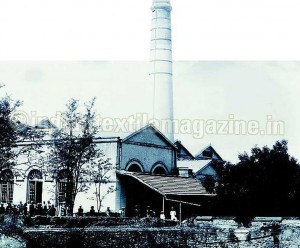By Rajesh Govindarajulu, Former Governing Council Member – Indian National Trust for Art and Cultural Heritage (INTACH)
Coimbatore, the Rome of the Kongunad region in Tamil Nadu, was part of the ancient River Noyyal civilization. The river which happens to be the central tributary of the Cauvery river considerably contributed to the Coimbatore regions peace and prosperity. Centuries ago when much of Mediterranean Europe, Africa and Asia was under the Roman yoke, Coimbatore was part of the trade route between the eastern and western coasts of peninsular India.
It was around this time that spices, agricultural implements, cornelian jewellery and cotton textiles were exported from Kongunad to Rome. In return, the people of this region earned gold and silver coins which formed part of the Roman currency. The fabric used for the Toga, a dress used by the aristocrats of Rome, was from the Coimbatore region, and the women of Rome almost fell in love with the fabulous cornelian jewellery from this area.
Over the years, imports from India drained the Roman treasury, and an anti-dumping duty had to be imposed by the Roman administration on goods from the Coimbatore region. A Roman settlement came up at Vellalore on the outskirts of Coimbatore, and nowadays INTACH has been organizing the one-week tour of the spice route via the Kongunad region. Excavations have brought to light the coins belonging to several Roman emperors, including Augustus Caesar, Tiberius and Constantine. Several eminent historians and archeologists have written about the hoary history of textiles of the Coimbatore region.
Over a hundred ports continued to export textiles from southern India, and India was a leading producer of textile goods for centuries. The 14th century saw the establishment of the great Vijayanagar Empire, and a number of cotton farmers migrated from the Telugu parts of the empire to the Tamil-speaking Kongunad region over the next 200 years. They came along with their seeds and began cultivating cotton in the black cotton soil of the region.
The weavers of the empire followed suit and established weaving centres known for quality in the Sukravarpet area of Coimbatore. Their cotton sarees and turbans were much liked in places like Rajasthan. In fact, there was a time when fabric for more than hundred varieties of turban was made in Coimbatore.
The Europeans who came in after the discovery of a new route to India by Vasco de Gama in 1498 continued to take Indian textiles. However the Industrial Revolution in Europe made the textile industry more efficient in Europe, and the Indian industry began to suffer in the hands of Lancashire textiles. It was at this juncture that Sir Robert Stanes, the pioneering and responsible entrepreneur, settled in Coimbatore and founded Coimbatore Spinning and Weaving Mills in 1888. He took financial help from the estate owners in the Nilgiris and from European bankers from Chennai. This sowed the seeds of modern textile industry in this part of the country.
The emergence of C.S. & W. Mills motivated others to set up mills in Coimbatore. Mall Mills came up in 1900. This was followed by the setting up of Kaleeswara in 1906, Ranga Vilas in 1922, Radhakrishna in 1924, Cambodia in 1928 and Vasantha in 1929. The great pioneering textile entrepreneur, G. Kuppuswamy Naidu, once visited C.S. & W. Mills as a tourist by paying one anna as tour charge. He was motivated by Sir Robert Stanes to establish his own Lakshmi Mills.
The great depression of 1929 severely damaged the financial strength of a number of Bombay mills. Soon a new kind of textile competition brought in cheaper Japanese textiles. This gave an opportunity for Coimbatore mills to expand their horizon. At the same time, many members of the agrarian community considered spinning as a natural forward integration activity to agriculture and entered the scene.
While Coimbatore continued to stay ahead in textiles, it rose to the clarion call of the Father of the Nation, Mahatma Gandhi, and Kovai Khadar Ayyamuthu, the freedom fighter and the grandson of the gentleman who supplied cotton to C.S. & W. Mills. He took up the cause of khadi at the behest of Gandhiji and turned around the khadi society in Tamil Nadu into a profitable one prior to the Second World War. His role was much appreciated by the Mahatma, and Kasturba herself took personal care of Ayyamuthu when he visited the Wardha Ashram. He improved the quality of khadi and once again proved a point in textiles as a hard working and efficient person from this part of the country.
The period prior to the Second World War saw the establishment in Coimbatore and around of huge mills like Gnanambikai, Sharadha, Rajalakshmi, Pioneer, Coimbatore Cotton and Mills, and in the mofussil, mills like Dhanalakshmi, Thirumurthi and Palani Andavar. The 1939-45 War brought in super profits, and the textile industry continued to expand. The Southern India Mills Association (SIMA) came into being under the leadership of R.K. Shanmukham Chetty who was to later become the first Finance Minister of Independent India, with P.S. Sathappa Chettiar as its first Chairman. The Association grew under the dynamic leadership of great industrialists like R. Venkataswamy Naidu, and the Independent India saw the establishment of the Southern India Textile Research Association (SITRA) in Coimbatore. Eminent leaders like textile scientist Padmabhushan Kasthuri Srinivasan took SITRA to greater heights.
The post-War period saw the role and contribution of textile pioneers like G.K. Devarajulu and G.R. Govindarajulu of the PSG family and textile technocrat industrialists like K. Venkatesalu from Coimbatore. By this time, Coimbatore came to be known as the Manchester of South India.
Coimbatore became the prosperous Tirumala Tirupathi of Kongunad, thanks to the hard work of the people of the region who seized every opportunity in the textile arena to reap rich dividends for the region.

